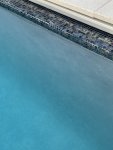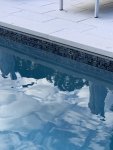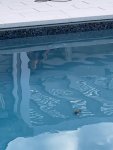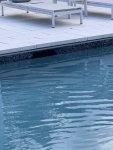Hi All, I just had a pool built last summer (we finished our second season), and i have terrible build up on my glass tile above the water line. I have an auto safety cover, which limits my ability to raise the water level to try and clear the calcium with the water that may be treated. My pool guy said it requires tons of muriatic acid and scrubbing. I tried myself spraying some diluted acid and scrubbing, but nothing. THe tiles also have a white fog building up. I tried vinegar too. No luck.
I am also reading about MAx Stripp blasting. Anyone have experience here? Why is this happening? I have been brushing the pool religiously including the glass tiles above the water line. Can anyone recommend a service provider in the Jersey Shore area that may be able to help? Some pics attached.
Any help would be greatly appreciated!
I am also reading about MAx Stripp blasting. Anyone have experience here? Why is this happening? I have been brushing the pool religiously including the glass tiles above the water line. Can anyone recommend a service provider in the Jersey Shore area that may be able to help? Some pics attached.
Any help would be greatly appreciated!






